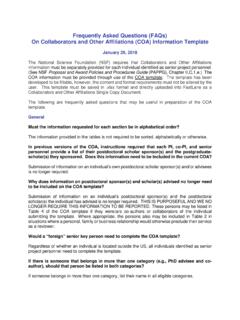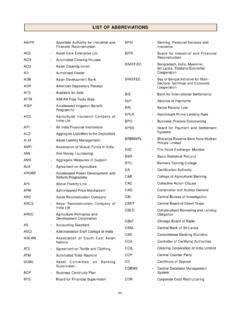Transcription of Dear Colleague Letter: Special Guidelines for Submitting ...
1 NATIONAL SCIENCE FOUNDATION2415 EISENHOWER AVENUEALEXANDRIA, VIRGINIA 22314 NSF 22-031 Dear Colleague Letter: Special Guidelines for SubmittingCollaborative Proposals under National Science Foundation (NSF)and Natural Sciences and Engineering Research Council ofCanada (NSERC) Collaborative Research Opportunities inArtificial Intelligence and Quantum ScienceDecember 16, 2021 Dear Colleague :The National Science Foundation (NSF) and the Natural Sciences and Engineering Council of Canada (NSERC) have signed a memorandum of understanding (MOU) on Research Cooperation. The MOU provides an overarching framework to encourage collaboration between and Canadian research communities and sets out the principles for developing jointly supported activities. The MOU provides for an international collaboration arrangement whereby researchers may receive funding from NSF and Canadian academic researchers may receive funding from the benefits of collaboration, the goal of this collaborative research opportunity is to help reduce some of the current barriers to working internationally in areas of mutual interest.
2 Through a lead agency model, NSF and NSERC will address these issues by allowing and Canadian research teams to submit a single collaborative proposal that will undergo a single review process at NSF, which will be the lead collaborative opportunity described in this Dear Colleague Letter (DCL) remains in effect until archived. This is not a single-year NSF-NSERC collaborative research opportunity focuses specifically on discoveries and innovations in the areas of artificial intelligence and quantum science. Collaborative research proposals will be accepted to the NSF programs listed below. Note that deadlines and due dates vary by Computer and Information Science and Engineering Core Programs( )Small Projects and Office of Advanced Cyberinfrastructure (OAC) Core Projects1onlyNSF Computer and Information Science and Engineering Secure and TrustworthyCyberspace Program (Secure and Trustworthy Cyberspace)Core Small Projects onlyNSF Foundational Research in Robotics (FRR)( )NSF Engineering Directorate, Division of Electrical, Communications and CyberSystems( )NSF Engineering Directorate, Division of Civil, Mechanical and ManufacturingInnovation( )NSF Engineering Directorate, Division of Chemical, Bioengineering, Environmental, andTransport Systems ( )Proposals are expected to adhere to the areas of science, funding limits, and grant durationsfor the NSF-participating programs (see list above).
3 Limits for researchers on thenumber of proposal submissions are described in the NSF-participating are also expected to adhere to the funding limits and grant durations for NSERC'sAlliance Grants ( ). For the purposes of this DCL, NSERC does not have a requirementfor partner organizations or contributions from partner organizations. In cases where one ormore private sector organizations is involved in the proposal, additional requirements mayapply pursuant to Government of Canada Guidelines for the development of researchpartnerships. Canadian researchers are encouraged to consult the Safeguarding YourResearch portal for further are advised that all documents submitted to NSF or NSERC may be shared withthe other agency in order to implement the two-way agency activities. By Submitting , principalinvestigators agree that information contained in a proposal may be shared betweenagencies for the purposes consistent with program objectives.
4 Principal investigators in and in Canada are responsible for ensuring that all co-applicants and collaborators areaware of the rules concerning the disclosure of information contained in the is subject to the Access to Information Act and the Privacy Act. The information youprovide is stored in a series of NSERC data banks which are described in Information aboutprograms and information holdings. You must ensure that others listed in the proposal haveagreed to be PREPARATION AND SUBMISSIONP roposals will be submitted by organizations to NSF. The proposals will be reviewed byNSF in competition with other proposals received for the same funding round of the programto which the proposal is submitted using NSF's merit review process. NSERC will check that2the Canadian investigators have an active and appropriate role and confirm their eligibility atthe onset of the process. NSERC will not conduct a parallel review and will not are no separate NSF funds available for these efforts; proposals must compete with allother proposals submitted to the relevant NSF program for the competition to which theproposal is submitted and must succeed on the strengths of their intellectual merit andbroader DECISIONA fter the reviews are received and final recommendations for funding made, NSFcommunicates the outcome of the merit review to the Principal Investigator (PI) andNSERC communicates with the Canadian a proposal is recommended for funding, the organization(s) will be supported by NSFand the eligible Canadian applicants will be supported by NSERC.
5 NSF and NSERC staff willreview budgets to ensure that there is no duplication in NSF and NSERC have different funding cycles, it is possible that some projects willhave different start dates or delayed start dates in order to wait until funds become decisions may be subject to budget limits. The number of projectsselected for funding and the total amount to be allocated will depend on the number andquality of the submitted proposals and the available funding for each participating NSF programs with deadlines, proposals are due at NSF by the submissiondates indicated in the program solicitation or program description of the participatingprograms listed participating NSF programs without target dates or deadlines for submission, proposalsmay be submitted at any time. Proposals submitted late in a given fiscal year, whichruns from October 1 through September 30, may be held over for consideration in thefollowing fiscal year.
6 In general, proposal review is completed within six months ofsubmission. Proposers may wish to consult a program director in the relevant program abouttiming of The proposed work submitted under an NSF-NSERC collaboration must represent anintegrated collaborative effort. The Project Summary and Project Description of theproposal submitted to NSF must include a description of the collaboration, including anexplanation of the role(s) of the Canadian collaborator(s) and an explanation of how theteam will work The proposal must describe the intellectual merits of the proposed research, includingthe value of the international collaboration, and the anticipated societal benefits (broaderimpacts) of the effort. Broader impacts are an NSF review requirement, so the proposalshould include societal benefits relevant to the and should also include benefitsrelevant to NSF proposers should follow NSF data policies.
7 The PIs are strongly encouraged todescribe efforts to make the data, codes, and other outputs of the proposed researchfindable, accessible, inter-operable and reusable, through use of publicly accessibledata repositories or other open access NSF proposers should indicate only the expenses on the NSF budget. TheCanadian budget and budget justification must be included in the NSF proposal as asupplementary document (see Additional Documents). The Budget Justificationsection of the NSF proposal should clearly differentiate the budget from any similarfunds requested by the Canadian team and justify the full project budget. Proposals thatrequest duplicative funding may be returned without The proposal must be submitted to a participating NSF program in English by a , using the NSF FastLane system ( ), ( ), or ( ).Proposals must be submitted in accordance with the standard requirements describedin the NSF Proposal & Award Policies & Procedures Guide (PAPPG) and comply withrequirements in the relevant program solicitation or program description of the NSF-participating programs (referenced above).
8 Where programs have a solicitation, therequirements in the solicitation take precedence over those listed in the By Submitting , PIs and their organizations agree that NSF may share anonymizedreviews and other documents pertaining to the review process with the For those participating NSF programs with limits on the number of proposals that anindividual may submit in a year, involvement in a joint international proposal will counttowards the limit on number of submissions in which an individual may participate as aPI or co-PI of a proposal, or senior lead investigator of a The title of the proposal should be prefixed with "NSF-NSERC:".9. If the proposal is submitted as part of a set of collaborative proposals from multipleorganizations, the title of the proposal should begin with "Collaborative Research:"followed by "NSF-NSERC:".10. Do NOT check "collaborative" proposal unless more than one organizationwill be Submitting the same proposal for separate funding ( , the "collaborative" checkbox only applies if there is more than one collaborating organization on the side,each Submitting the same proposal).
9 11. For proposals submitted to NSF, Canadian personnel should be listed as "non-NSFfunded Collaborators." Guidance on information to provide for "non-NSF fundedCollaborators" is Sketch - Required. The biographical information must be clearlyidentified as "non-NSF funded Collaborators" biographical information and4uploaded as a single PDF file in the Other Supplementary Documents section ofthe proposal. Use of a specific format is not and Other Affiliations (COA) Information - Optional but COA information should be provided through the use of the COA template,identified as "non-NSF funded Collaborators" COA information, and uploaded as aPDF file in the Single Copy Documents section of the and Pending Support - Not of Prior NSF Support - Not For projects involving human subjects or vertebrate animals, proposals should followboth NSF and NSERC policies, Submitting documentation to each as awareness of the PIs, the Canadian PIs must comply with the following Guidelines :Members of the Canadian research team must submit a "Letter of Intent" to NSERC atleast 8 weeks prior to submission of the full proposal to NSF.
10 The Alliance Grants Letterof Intent (LOI) for this call is available on the NSERC Online system and the instructions andfunding limits are available on the NSERC website. The LOI should not exceed 3 pages,excluding references, and respect NSERC online presentation and attachment NSERC Eligibility Criteria for Faculty LOI should outline the research proposed, research teams involved, and bottom-lineestimates of funding to be requested using Canadian dollars from both the NSF and research description should include: a brief summary of the main objectives andresearch challenges of the proposed research and the expected outcomes and benefits. Aplan to foster equity, diversity, and inclusion (EDI) within the research and trainingenvironment must also be presented. The LOI and the eligibility of the Canadian researchteam members will be reviewed internally by NSERC. The plan to foster EDI within theresearch and training environment is a screening criterion.











